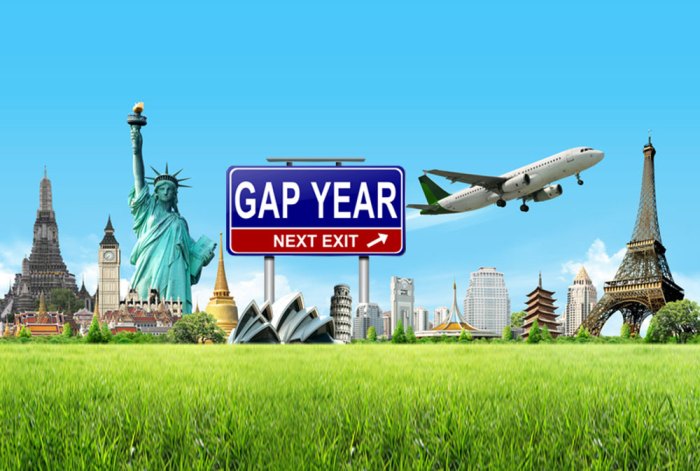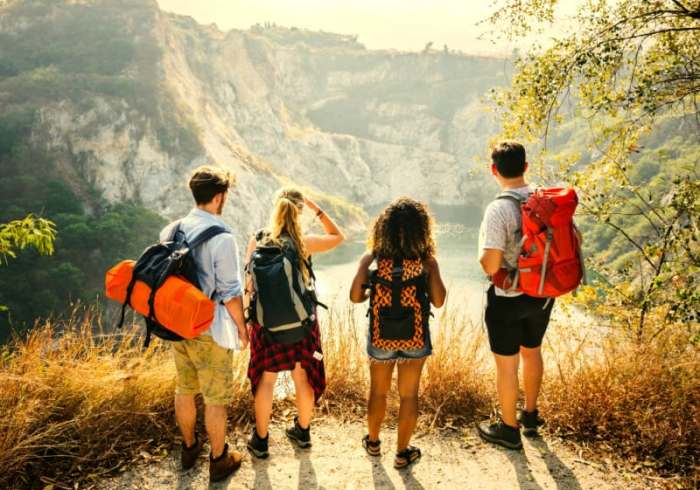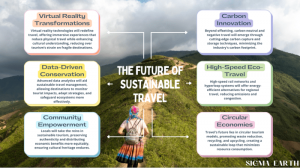
Gap year travel for students offers an unparalleled opportunity for personal growth, cultural immersion, and unforgettable experiences. This transformative journey allows students to explore the world, broaden their horizons, and gain valuable life skills beyond the classroom. Whether you envision backpacking through Southeast Asia, volunteering in South America, or embarking on a structured tour of Europe, a well-planned gap year can be both enriching and rewarding.
This guide provides comprehensive information to help students navigate the planning process, from budgeting and finding affordable travel options to ensuring safety and health. We’ll explore various travel styles, activities, and accommodation choices, empowering you to craft a gap year adventure tailored to your interests and resources. Learn how to maximize your budget, discover hidden travel gems, and create memories that will last a lifetime.
Road Trip Guides: Gap Year Travel For Students
Embarking on a West Coast road trip is a quintessential American experience, offering breathtaking scenery, diverse cultures, and unforgettable adventures. This guide provides a framework for planning your journey, covering itinerary suggestions, essential packing lists, and transportation considerations. Careful planning will ensure a smooth and enjoyable trip.
West Coast Road Trip Itinerary: Seattle to San Diego
This itinerary focuses on a route from Seattle, Washington, to San Diego, California, highlighting key locations and potential activities. Adjust the duration and specific stops based on your interests and available time. The suggested timeframe is approximately 3 weeks, allowing for flexibility and exploration.
- Seattle, WA (2 days): Explore Pike Place Market, visit the Space Needle, and enjoy the vibrant city atmosphere. Consider a ferry ride to Bainbridge Island for stunning views.
- Portland, OR (2 days): Discover the city’s thriving food scene, explore Powell’s City of Books, and wander through Washington Park. Consider a day trip to the Columbia River Gorge.
- Crater Lake National Park, OR (1 day): Marvel at the breathtaking beauty of Crater Lake, hike along the rim, and take in the panoramic views. Boat tours are available.
- Redwood National and State Parks, CA (2 days): Hike among the majestic redwood trees, explore the diverse ecosystems, and enjoy the tranquility of the forest. Consider a guided tour for a deeper understanding of the area.
- San Francisco, CA (3 days): Visit the Golden Gate Bridge, explore Alcatraz Island, ride a cable car, and experience the city’s unique culture. Allow time for exploring different neighborhoods.
- Big Sur, CA (2 days): Drive along the iconic Highway 1, stop at scenic overlooks, and hike to stunning viewpoints. Consider staying overnight in a charming coastal town.
- Los Angeles, CA (3 days): Explore Hollywood, visit Griffith Observatory, relax on the beaches, and experience the city’s diverse attractions. Consider a theme park visit.
- San Diego, CA (2 days): Visit Balboa Park, explore the Gaslamp Quarter, relax on the beaches, and enjoy the city’s laid-back atmosphere. Consider visiting the San Diego Zoo.
Road Trip Essentials Checklist
Thorough preparation is key to a successful road trip. This checklist covers car maintenance, emergency supplies, and entertainment to ensure a smooth and enjoyable journey.
- Car Maintenance: Check oil levels, tire pressure, fluids, and lights before departure. Ensure you have a spare tire and basic tools.
- Emergency Supplies: Pack a first-aid kit, jumper cables, flashlight, basic tools, and a roadside assistance contact number. Consider a portable charger for your phone.
- Navigation & Communication: Download offline maps, ensure your phone has sufficient battery life, and consider a GPS device. Pack a physical map as a backup.
- Entertainment: Pack books, podcasts, audiobooks, or music playlists to keep yourselves entertained during long drives. Games and travel journals can also be enjoyable.
- Clothing & Personal Items: Pack appropriate clothing for varying weather conditions, toiletries, sunscreen, and insect repellent.
- Food & Drinks: Pack snacks and drinks to avoid relying solely on roadside stops. A cooler can help keep perishable items fresh.
Renting a Car vs. Public Transportation
Choosing between renting a car and using public transportation significantly impacts the cost and flexibility of your West Coast road trip.
| Factor | Renting a Car | Public Transportation |
|---|---|---|
| Cost | Higher initial cost, but potentially more cost-effective for larger groups or longer distances. Fuel, tolls, and parking add to the expense. | Lower initial cost, but can be more expensive for longer distances due to multiple tickets and potential delays. |
| Flexibility | Greater flexibility to explore off-the-beaten-path locations and customize your itinerary. | Less flexible, limited to scheduled routes and times. May require more planning and coordination. |
| Convenience | More convenient for carrying luggage and transporting items. | Can be less convenient for carrying large amounts of luggage. |
| Example | A family of four traveling for three weeks might find renting an SUV more cost-effective than relying on multiple flights and rental cars. | A solo traveler focusing on major cities might find public transportation sufficient and more budget-friendly. |
Budget Accommodation Tips
Finding affordable accommodation is crucial for making the most of your gap year travels. Smart choices in this area can significantly impact your overall budget, freeing up funds for experiences and activities. This section Artikels various strategies and resources to help you secure comfortable and cost-effective lodging during your adventures.
Websites and Apps for Finding Affordable Accommodation
Several online platforms specialize in connecting travelers with budget-friendly accommodation options. These resources offer a wide range of choices, allowing you to compare prices and amenities before making a booking. Using these tools effectively can save you both time and money.
- Hostelworld: A comprehensive platform dedicated to hostels worldwide, offering detailed descriptions, photos, and user reviews.
- Booking.com: While offering a broader range of accommodation, Booking.com also features a robust filter system allowing you to easily find budget hotels and guesthouses.
- Airbnb: A popular platform for finding private rooms, apartments, and entire homes, often offering more space and amenities than traditional hotels at competitive prices.
- Hostelbookers: Similar to Hostelworld, this platform focuses specifically on hostels and provides a user-friendly interface for searching and booking.
- Google Hotels: Google’s hotel search integrates information from various booking sites, allowing for easy comparison shopping.
Negotiating Lower Prices on Accommodation
Securing the best possible price often involves proactive strategies and a willingness to negotiate. While not always successful, these techniques can lead to significant savings.
Booking in advance often yields lower prices, particularly during peak seasons. Websites and apps often offer early-bird discounts or promotions for advance bookings. Conversely, last-minute bookings can sometimes result in lower prices, especially if the accommodation is struggling to fill rooms. Loyalty programs offered by hotel chains or booking platforms can provide discounts or perks like free upgrades or complimentary breakfast.
Directly contacting the accommodation provider, whether it’s a hostel, guesthouse, or small hotel, can sometimes lead to negotiation opportunities. Politely inquiring about potential discounts for longer stays or mentioning that you found a lower price elsewhere can sometimes result in a reduced rate.
Advantages and Disadvantages of Different Budget Accommodation Types
Each type of budget accommodation presents unique advantages and disadvantages that should be considered based on your travel style and preferences.
| Accommodation Type | Advantages | Disadvantages |
|---|---|---|
| Hostels | Social atmosphere, budget-friendly, often centrally located. | Shared rooms and facilities, potential noise, less privacy. |
| Airbnb | More privacy, often includes kitchen facilities, can be more spacious. | Potentially higher cost than hostels, requires careful vetting of hosts and properties. |
| Couchsurfing | Free accommodation, cultural immersion, opportunity to meet locals. | Relies on the hospitality of strangers, requires careful planning and communication, less privacy and flexibility. |
| Budget Hotels | Private rooms and bathrooms, more amenities than hostels, consistent quality. | Can be more expensive than hostels or Airbnb, may lack character or unique local experience. |
Vacation Rentals and Airbnb

Airbnb and similar vacation rental platforms have revolutionized the travel landscape, offering an appealing alternative to traditional hotels and hostels, particularly for gap year travelers seeking flexibility and potentially lower costs. This section explores the advantages and disadvantages of utilizing Airbnb during your gap year, providing guidance on finding safe and reliable accommodations and comparing its cost-effectiveness with other lodging options.Airbnb offers a diverse range of properties, from cozy private rooms to entire apartments and houses, catering to various budgets and travel styles.
However, it’s crucial to weigh the pros and cons carefully before booking.
Airbnb Advantages and Disadvantages
Choosing Airbnb for your gap year accommodation involves considering both the benefits and drawbacks. A balanced perspective is essential for making an informed decision.
- Cost-Effectiveness: Airbnb can often be more affordable than hotels, especially for longer stays or groups. This is particularly true for larger properties that can be shared among several travelers, significantly reducing individual costs. However, prices can fluctuate depending on location, season, and demand, sometimes exceeding hotel rates, especially in peak tourist seasons.
- Privacy and Space: Unlike hostels or hotel rooms, many Airbnb rentals offer greater privacy and personal space. Having access to a kitchen allows for cost savings by preparing meals, while amenities like laundry facilities can be convenient for longer trips. Conversely, some Airbnb rentals might lack the amenities and services of hotels, such as daily housekeeping.
- Local Experiences: Airbnb often provides a more immersive and authentic local experience. Staying in a residential neighborhood allows you to interact with locals and gain insights into the culture and lifestyle of your destination, unlike the more transient atmosphere of hotels. However, this immersive experience may also lack the structured activities and social opportunities provided by some hostels.
Finding Safe and Reliable Airbnb Rentals
Ensuring safety and reliability when booking an Airbnb is paramount. Diligent research and careful vetting of hosts and properties are crucial for a positive experience.
- Verify Host Credentials: Thoroughly examine the host’s profile, paying attention to their response rate, review history, and verification badges. Look for hosts with numerous positive reviews and a history of successful bookings. Airbnb’s verification system provides various badges indicating confirmed identity, email address, and phone number verification, adding an extra layer of security.
- Read Reviews Carefully: Don’t just focus on the overall rating; read individual reviews to understand the nuances of the experience. Pay close attention to comments about cleanliness, accuracy of the listing description, and the host’s responsiveness. Negative reviews, even if few, can highlight potential issues.
- Check Property Details: Carefully review the property description, photos, and amenities listed. Confirm the location, access details, and any house rules. Contact the host directly with any questions or concerns before booking. Ensure the amenities listed are accurate and meet your needs.
Cost Comparison with Other Accommodation Options
The cost-effectiveness of Airbnb varies depending on several factors and needs to be compared to other options available.
For solo travelers on a tight budget, hostels are often the most economical choice. Hotels typically offer more amenities and services but come at a higher price point. Airbnb’s cost-effectiveness lies in its flexibility; for groups or longer stays, it can be significantly cheaper than hotels per person. For example, renting a whole apartment with friends can be far more affordable than booking multiple hotel rooms.
However, in popular tourist destinations during peak seasons, Airbnb prices can rival or even surpass hotel rates.
Hotel Reviews and Tips

Choosing the right hotel can significantly impact your gap year travel experience. A well-chosen hotel can provide a comfortable base for exploration, while a poor choice can lead to unnecessary stress and discomfort. This section will guide you through finding and selecting hotels that meet your needs and budget.
Hotel Booking Websites and Apps
Several online platforms specialize in hotel bookings, each offering unique features and price points. Effective comparison shopping is key to securing the best deal. Popular websites and apps include Booking.com, Expedia, Hotels.com, Kayak, and TripAdvisor. These platforms allow you to filter your search by price, location, amenities, and guest ratings, making it easier to find hotels that align with your preferences.
Remember to check multiple sites for the same hotel; prices can fluctuate significantly between platforms. Pay attention to cancellation policies and hidden fees before confirming your booking.
Interpreting Hotel Reviews and Ratings
Hotel reviews provide invaluable insights into the actual guest experience. When reading reviews, focus on recurring themes rather than individual opinions. Look for consistent feedback regarding cleanliness, staff friendliness, location convenience, and noise levels. Pay close attention to negative reviews, but try to discern whether the issues raised are isolated incidents or systemic problems. Consider the reviewer’s profile and travel style – a budget traveler’s perspective might differ from that of a luxury traveler.
A high average rating with a reasonable number of reviews is generally a good indicator of quality.
Maximizing Your Hotel Stay
To get the most out of your hotel stay, consider these tips: Check-in early if possible to maximize your time. Take advantage of hotel amenities, such as pools, fitness centers, and complimentary breakfasts. Communicate any special requests or needs to the hotel staff in advance. Pack appropriately for the climate and activities you’ll be undertaking. Learn basic phrases in the local language to enhance your interactions with staff.
Utilize hotel resources, like maps and local guides, to plan your day trips. Be respectful of hotel policies and other guests. Regularly check for discounts or special offers.
Types of Hotels: A Comparison
Budget hotels prioritize affordability, often sacrificing amenities like elaborate decor or extensive room service. They are ideal for travelers on a tight budget who prioritize location and cleanliness over luxury. Boutique hotels offer a unique and personalized experience, typically characterized by stylish design, intimate settings, and exceptional customer service, though they usually command higher prices. Luxury hotels provide top-tier accommodations and services, including lavish rooms, fine dining options, and comprehensive concierge services.
The choice depends entirely on your priorities and budget. Location is another crucial factor to consider regardless of hotel type; a hotel’s proximity to attractions, transportation, and dining options greatly affects the overall experience.
RV and Camper Travel
Embarking on a gap year adventure in an RV or campervan offers a unique blend of freedom and exploration. This mode of travel allows for immersive experiences, unlike traditional hotels or hostels, providing a home-on-wheels for your journey. However, it’s crucial to weigh the advantages and disadvantages before committing to this style of gap year travel.RV and camper travel presents a compelling alternative for gap year students seeking a flexible and independent travel experience.
The ability to wake up in a new location each day, coupled with the cost-saving potential of self-catering, makes it an attractive option. Conversely, the responsibility of vehicle maintenance, campsite bookings, and navigating potential mechanical issues should be carefully considered.
Advantages and Disadvantages of RV and Camper Travel
RV and campervan travel offers significant advantages in terms of cost-effectiveness and flexibility. By preparing meals in the vehicle, students can drastically reduce food expenses compared to eating out constantly. The freedom to explore remote locations and change itineraries spontaneously is another major benefit. However, unexpected repairs can be costly, and the initial investment in renting or purchasing an RV can be substantial.
Furthermore, the physical demands of driving and maintaining the vehicle should not be underestimated. A realistic budget encompassing fuel, maintenance, campsites, and potential repairs is essential.
Essential Items for RV and Camper Travel, Gap year travel for students
A well-prepared packing list is paramount for a smooth and enjoyable RV road trip. Safety should be the top priority, encompassing emergency supplies such as a first-aid kit, a fully charged phone with a portable charger, and a comprehensive toolkit for minor vehicle repairs. Cooking supplies should include basic utensils, cookware, and non-perishable food items. Entertainment options such as books, games, and downloaded movies or music can help pass time during travel or downtime at campsites.
Don’t forget comfortable bedding, clothing appropriate for various weather conditions, and personal hygiene items.
Sample RV Road Trip Itinerary: Pacific Coast Highway
This itinerary focuses on a two-week journey along the iconic Pacific Coast Highway, starting in San Francisco and ending in Los Angeles. This route offers stunning coastal views, diverse activities, and a range of campsites.
- Days 1-3: San Francisco to Monterey: Explore San Francisco’s iconic landmarks, then drive down the coast, stopping at scenic viewpoints and beaches. Camp at Pfeiffer Big Sur State Park for stunning redwood forest views.
- Days 4-6: Big Sur to Santa Barbara: Continue along the PCH, enjoying breathtaking coastal drives. Hike in the Julia Pfeiffer Burns State Park to see McWay Falls. Camp at El Capitan State Beach, known for its beautiful coastline and proximity to Santa Barbara.
- Days 7-9: Santa Barbara to Malibu: Visit Santa Barbara’s charming downtown and explore the beaches. Enjoy the vibrant atmosphere of Malibu and its famous beaches. Camp at Malibu Creek State Park for hiking and exploring.
- Days 10-12: Malibu to Los Angeles: Explore the diverse neighborhoods of Los Angeles, including Hollywood and Beverly Hills. Visit Griffith Observatory for panoramic city views. Camp at Leo Carrillo State Park, known for its dramatic cliffs and tide pools.
- Days 13-14: Los Angeles: Spend the final days exploring Los Angeles’s many attractions, before departing.
Note: This is a sample itinerary, and the duration of stay at each location can be adjusted based on personal preferences. Campsite reservations are highly recommended, especially during peak season. Always check weather conditions and road closures before embarking on any leg of the journey.
Unique Stays and Treehouses
Choosing unique accommodation can significantly enhance your gap year travel experience, offering memorable stays beyond the typical hotel or hostel. These alternative options provide opportunities for immersion in local culture and environments, often at a range of price points. This section explores several unique accommodation types and compares them to more traditional options.
Five Unique Accommodation Options
Five memorable accommodation options for gap year travelers include treehouses, yurts, glamping sites, eco-lodges, and converted barns. Treehouses offer a whimsical and secluded experience, often nestled amongst lush forests. Imagine waking up to the sounds of birdsong and enjoying breathtaking views from your private perch. Yurts, traditional nomadic dwellings, provide a unique cultural immersion, often found in rural or mountainous areas.
They offer a blend of comfort and simplicity, with circular designs and cozy interiors. Glamping sites combine the charm of camping with the comfort of a luxurious stay. These sites often feature stylish tents, cabins, or yurts with amenities such as comfortable beds, private bathrooms, and electricity. Eco-lodges focus on sustainability and environmental responsibility, integrating seamlessly into their natural surroundings.
These often feature locally sourced materials, renewable energy, and eco-friendly practices. Finally, converted barns offer a rustic and charming experience, blending historical architecture with modern comforts. These repurposed spaces often feature exposed beams, high ceilings, and a unique character.
Cost and Experience Comparison
The cost and experience of unique accommodations vary significantly compared to traditional hotels and hostels. Generally, unique accommodations tend to be more expensive than hostels, offering a higher level of privacy and often a more immersive experience. However, many unique accommodations are competitively priced with budget-friendly hotels, especially when considering the overall experience. Hostels, while budget-friendly, often lack the privacy and unique character of alternative options.
Hotels provide a level of comfort and convenience, but can lack the personalized experience and cultural immersion often found in unique stays. For example, a night in a basic hostel dorm might cost $20-$40, while a night in a glamping tent could range from $80-$150, and a treehouse stay might start at $150 per night. The added cost often reflects amenities, privacy, and the overall uniqueness of the experience.
Finding and Booking Unique Accommodations
Finding and booking unique accommodations requires a more proactive approach than simply searching for hotels. Websites specializing in unique stays, such as Airbnb, Glamping Hub, and Booking.com (filtering by unique accommodation types), are excellent resources. Thoroughly research potential accommodations, paying close attention to reviews focusing on cleanliness, location, and the overall experience. Verify the accuracy of listed amenities and check for any hidden fees.
Contact the host directly if you have any questions or concerns before booking. Reading multiple reviews from different platforms can provide a more comprehensive understanding of the accommodation. Looking at photos and videos from previous guests can help you get a better sense of the space and its surroundings.
Houseboat and Yacht Stays
Houseboat and yacht stays offer a unique and adventurous alternative to traditional gap year accommodation, providing a blend of independence, exploration, and relaxation. However, they also come with specific considerations regarding cost, planning, and practicalities that prospective gap year travelers should carefully weigh. This section will explore the appeal and potential drawbacks of these unique accommodation options, comparing them to more conventional choices and highlighting ideal destinations.Houseboat and yacht stays differ significantly from hotels, hostels, or even vacation rentals in terms of both experience and cost.
The immersive nature of living on the water provides a completely different perspective on a destination, allowing for exploration of waterways and a closer connection with nature. However, this unique experience comes at a price, often exceeding the cost of land-based accommodations, particularly for yachts. Houseboats, while generally less expensive than yachts, still require careful budgeting for fuel, mooring fees, and potential maintenance.
Furthermore, the level of independence and self-sufficiency required for these stays necessitates a degree of planning and preparedness not always needed with other accommodation types.
Cost and Experience Comparison
Houseboat rentals typically range from a few hundred to several thousand dollars per week, depending on size, location, and amenities. Yacht charters, on the other hand, can range from several thousand to tens of thousands of dollars per week, depending on the size and luxury of the vessel. This cost difference reflects the significant disparity in amenities and experiences.
Yachts often come with a crew, providing catering, cleaning, and maintenance services, while houseboats generally require self-catering and a higher degree of self-sufficiency. In comparison, a budget hostel might cost $20-$50 per night, while a mid-range hotel room could cost $100-$300 per night, and vacation rentals vary widely based on location and size. The immersive and unique experience of a houseboat or yacht stay, however, cannot be directly compared to the more conventional options; it’s a fundamentally different type of travel.
Popular Houseboat and Yacht Destinations
Houseboat stays are particularly popular in locations with extensive navigable waterways and picturesque scenery. The canals of Amsterdam, Netherlands, offer a charming and unique way to experience the city, with houseboats offering a cozy and intimate base for exploring the canals and nearby attractions. Similarly, the Kerala backwaters in India provide a tranquil and serene setting for houseboat journeys, offering stunning views of lush greenery and traditional village life.
The experience includes the opportunity to witness the daily lives of local communities and enjoy the peaceful rhythm of life on the water.Yacht charters, due to their higher cost, are typically chosen for more luxurious and adventurous experiences. The Greek Islands offer a classic yachting destination, with crystal-clear waters, charming harbors, and countless secluded coves to explore. A yacht charter allows for a personalized itinerary, visiting various islands at one’s own pace, enjoying swimming, snorkeling, and exploring the unique culture of each island.
The Caribbean Sea, with its stunning beaches and vibrant coral reefs, is another popular destination for yacht charters, offering opportunities for diving, fishing, and relaxation. The ability to tailor the itinerary to individual preferences is a significant advantage of yacht travel compared to pre-packaged tours or fixed itineraries.
Ultimately, a successful gap year hinges on careful planning, resourcefulness, and a spirit of adventure. By leveraging the tips and resources Artikeld in this guide, students can confidently embark on their gap year journey, transforming their dreams into reality. Remember that flexibility and adaptability are key; embrace the unexpected detours and cherish the invaluable lessons learned along the way. Your gap year is an investment in yourself – make the most of it!
Frequently Asked Questions
How do I get a student travel visa?
Visa requirements vary greatly by country. Check the embassy or consulate website of your destination country well in advance to determine the specific documents and procedures needed.
What about travel insurance?
Comprehensive travel insurance is crucial. It should cover medical emergencies, trip cancellations, lost luggage, and other unforeseen circumstances. Compare policies from different providers to find the best coverage at a reasonable price.
Is it safe to travel alone?
Solo travel can be incredibly rewarding, but it’s important to prioritize safety. Research your destination thoroughly, share your itinerary with someone at home, and be aware of your surroundings. Avoid walking alone at night in unfamiliar areas.
How can I meet other travelers?
Hostels are great places to connect with fellow travelers. Consider joining group tours or activities, or utilizing social media groups and forums dedicated to gap year travel.





